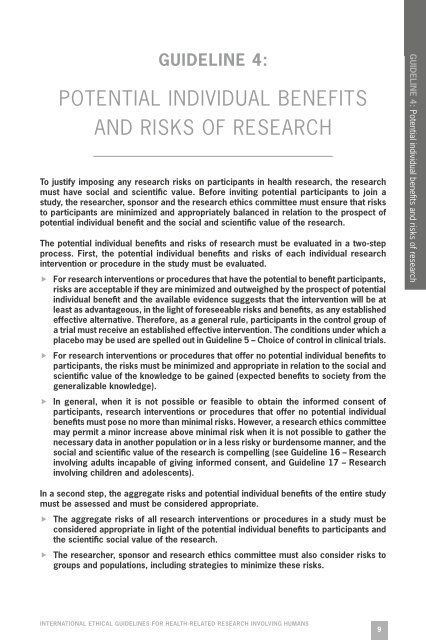International Ethical Guidelines for Health-related Research Involving Humans
WEB-CIOMS-EthicalGuidelines
WEB-CIOMS-EthicalGuidelines
You also want an ePaper? Increase the reach of your titles
YUMPU automatically turns print PDFs into web optimized ePapers that Google loves.
GUIDELINE 4:<br />
POTENTIAL INDIVIDUAL BENEFITS<br />
AND RISKS OF RESEARCH<br />
To justify imposing any research risks on participants in health research, the research<br />
must have social and scientific value. Be<strong>for</strong>e inviting potential participants to join a<br />
study, the researcher, sponsor and the research ethics committee must ensure that risks<br />
to participants are minimized and appropriately balanced in relation to the prospect of<br />
potential individual benefit and the social and scientific value of the research.<br />
The potential individual benefits and risks of research must be evaluated in a two-step<br />
process. First, the potential individual benefits and risks of each individual research<br />
intervention or procedure in the study must be evaluated.<br />
ff<br />
For research interventions or procedures that have the potential to benefit participants,<br />
risks are acceptable if they are minimized and outweighed by the prospect of potential<br />
individual benefit and the available evidence suggests that the intervention will be at<br />
least as advantageous, in the light of <strong>for</strong>eseeable risks and benefits, as any established<br />
effective alternative. There<strong>for</strong>e, as a general rule, participants in the control group of<br />
a trial must receive an established effective intervention. The conditions under which a<br />
placebo may be used are spelled out in Guideline 5 – Choice of control in clinical trials.<br />
ff<br />
For research interventions or procedures that offer no potential individual benefits to<br />
participants, the risks must be minimized and appropriate in relation to the social and<br />
scientific value of the knowledge to be gained (expected benefits to society from the<br />
generalizable knowledge).<br />
ff<br />
In general, when it is not possible or feasible to obtain the in<strong>for</strong>med consent of<br />
participants, research interventions or procedures that offer no potential individual<br />
benefits must pose no more than minimal risks. However, a research ethics committee<br />
may permit a minor increase above minimal risk when it is not possible to gather the<br />
necessary data in another population or in a less risky or burdensome manner, and the<br />
social and scientific value of the research is compelling (see Guideline 16 – <strong>Research</strong><br />
involving adults incapable of giving in<strong>for</strong>med consent, and Guideline 17 – <strong>Research</strong><br />
involving children and adolescents).<br />
Guideline 4: Potential individual benefits and risks of research<br />
In a second step, the aggregate risks and potential individual benefits of the entire study<br />
must be assessed and must be considered appropriate.<br />
ff<br />
The aggregate risks of all research interventions or procedures in a study must be<br />
considered appropriate in light of the potential individual benefits to participants and<br />
the scientific social value of the research.<br />
ff<br />
The researcher, sponsor and research ethics committee must also consider risks to<br />
groups and populations, including strategies to minimize these risks.<br />
INTERNATIONAL ETHICAL GUIDELINES FOR HEALTH-RELATED RESEARCH INVOLVING HUMANS<br />
9


